|
Terry Nichols Born on April Fool's Day, 1955, Terry Nichols might have faded into obscurity, just one more gun-loving, race-baiting, tax-hating, wife-buying loser with a crazy brother and some unsavory friends, living and dying pointlessly in the Midwest, leaving a legacy consisting of nothing more than a series of unpaid utility bills and a rusted coffee can full of cash buried in the backyard.
Born on April Fool's Day, 1955, Terry Nichols might have faded into obscurity, just one more gun-loving, race-baiting, tax-hating, wife-buying loser with a crazy brother and some unsavory friends, living and dying pointlessly in the Midwest, leaving a legacy consisting of nothing more than a series of unpaid utility bills and a rusted coffee can full of cash buried in the backyard. But one of those unsavory friends was Timothy McVeigh, and the wife Nichols purchased came from an al Qaeda stronghold in the Philippines. These two factors, mixed together in still unknown quantities, delivered Nichols from a quiet life and an unnoticed death, and transformed him into a celebrity killer, sharing a prison cell block with his fellow Terrorists and his intellectual betters, Ramzi Yousef and the Unabomber. How did this unremarkable crackpot end up in such dire straits? Many questions are still unanswered, but the general outline is known. Terry Nichols and his brother James appear to have had a reasonably normal childhood, although one has to wonder. Terry was an average student and a responsible child. He dropped out of college in the late 1970s and started trying to find himself. Unfortunately, his self was nowhere to be found. He worked a variety of unremarkable jobs, as a carpenter, a farm hand, an insurance salesman. None of them agreed with him. Nichols married Lana Walsh in 1981. They had a child, Josh, in 1982. In 1988, Nichols joined the Army, but that didn't agree with him either. He dropped out just a few months later, claiming a hardship discharge to raise his son after Lana divorced him.
Once out of the Army, it became clear to Nichols that his big problem was the lack of a good woman in his life, so he pulled out a catalog and began browsing. Traveling to the Philippines on a meals-and-wife included package, he arrived in Cebu City and hooked up with the love of his life, Marife Torres. Sure, they came from two different worlds! Sure, he was a white racist and she was a Filipina! Sure, she was 17 and he was pushing 40! Sure, she became pregnant with someone else's child after they were engaged! True love can not be denied! Just like Romeo and Juliet (except without the suicides and the inspiring romance part), the couple struggled mightily to overcome these obstacles and Mrs. Terry Nichols moved to the U.S. in 1991. The two moved in with Terry's brother James, who lived the life of a government-hating, gun-loving, survivalist-racist on a farm in Michigan. In 1992, Nichols began a years-long process of renouncing his citizenship, motivated by the U.S. government's unaccountable decision to let him rack up $40,000 in credit card debt, for which he was (quite understandably) sued. Those bastards! In court filings uncannily similar in tone to those later filed by alleged terrorist Zacarias Moussaoui, Nichols presented simple coherent arguments explaining his position in the credit card dispute: "I can see the 'Play on words', 'Smoke screening', 'Denying', 'Ignoring', and 'Twisting' that lawyers (attorneys) use of the Laws." In a 1994 filing, he would expand on his view that the government had willfully manipulated him into charging up $40,000 in debts. "Due to such shrewd entrapments (i.e., the Constitution, banks, courts, etc.), over the years I have unwittingly signed many of the related documents or contracts, some even under the 'perjury' jurat as was supposedly required. With American Law on this Citizen's side, I hereby REVOKE all such signatures and render them null and void (...) This is also my Lawful Notice that all such signatures of mine in the future, with such government or otherwise-adhesioned sources, are to be considered as under "TDC" and/or "without prejudice", whether appearing therewith or otherwise, including banks, licenses, etc."
Rage, RageWhatever. While all this was brewing, McVeigh had served in the Gulf War, then washed out of the Special Forces and subsequently quit the Army. Despite his own racism, he too was smitten with the new Mrs. Nichols, following the age-old honor code of white supremacy which allows a special enlightened exemption from separatism when the non-white person is a woman in a sexually subservient position (just ask Sally Hemmings).
McVeigh had drifted over the ranch on April 19, 1993, when federal authorities stormed the Branch Davidian, in a brutal attempt to suppress the sacred constitutional right to stockpile a small armory while impregnating 12-year-olds. Naturally, they were outraged. McVeigh started drifting much more purposefully after this, while Nichols continued to play out his meager life, except now with extra rage. By no later than September 1994, the dysfunctional duo had stoked their rage to the boiling point, and the Oklahoma City bombing plot was born. It's unclear how much preparation took place before this, but in September the two began buying ammonium nitrate fertilizer (a key bomb component) and stockpiling it around the Midwest, in storage units rented by Nichols under an alias. Nichols sent his wife back to the Philippines for a few months, while the conspirators did their initial work assembling the ingredients for the bomb, including purchases of fuel oil and the theft of detonation materials. In November 1994, Nichols allegedly robbed a gun dealer friend of McVeigh's named Roger Moore (not the James Bond actor). The robbery netted cash, valuables and guns, which were supposedly for the purpose of funding the bombing effort. (Nichols denied involvement in the robbery.) This is where things begin to get a little sticky in the "don't believe everything you're told" department. Instead of sending the money to McVeigh, who was in Buffalo, N.Y., for a family emergency, Nichols trucked over to Las Vegas, where he met with his ex-wife, Lana, who had married a man named Leonard Padilla (no apparent relation to Jose Padilla). While staying with the Padillas, Nichols secreted almost all of the cash and valuables in the house and a storage unit outside Las Vegas, leaving only the guns for McVeigh. He left a note with Lana to be opened only if he failed to return from the Philippines by January 28, which contained instructions "for the purpose of my death." The note specified that if his life insurance failed to pay off for "some reason," the cash and valuables were to be sent to Marife. He also left a cryptic death note for McVeigh, saying "go for it" and "as far as heat, none that I am aware of," as well as instructions for retrieving the fertilizer from storage. Nichols then left for the Philippines on a 60-day visa. His wife was staying there, but she wasn't expecting him, according to her testimony during his trial.
Bad Company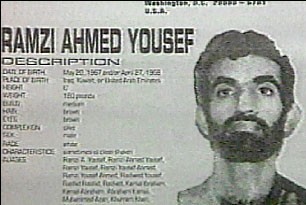 This is where the story gets really interesting. All of what follows is proven fact. We'll get to the suppositions in a minute.
This is where the story gets really interesting. All of what follows is proven fact. We'll get to the suppositions in a minute. In September 1994, just as Nichols and McVeigh began working on their bomb, al Qaeda expert bomb-builder Ramzi Yousef and his homicidal mastermind uncle, Khalid Shaikh Mohammed, had arrived in Manila with orders from Osama bin Laden to plan and launch attacks on the United States. Among the plans they hatched during this period was an ambition operation known as "Bojinka," which is apparently Serbo-Croation for "big bang." The plot called for five terrorists to plant bombs on 11 U.S.-bound airliners originating in the region, which would detonate nearly simultaneously over the Pacific. A second phase of the plan was a predecessor to the September 11 attacks — one or more plans would be hijacked or stolen, then crashed into prominent U.S. landmarks such as CIA headquarters, the Pentagon or the World Trade Center. The operatives who were to carry out the plan were never all definitively identified. Bojinka was set to launch on January 21, 1995, the exact date that Terry Nichols' 60-day visa was set to expire. In December, Yousef tested one of the Bojinka bombs on a flight from Manila to Tokyo. He got on the flight, planted the bomb and disembarked during a layover in Cebu City, the Philippines. The bomb went off on the second leg of the flight, killing one person, although the plane managed to make an emergency landing. At the exact same time, Terry Nichols was hanging out in Cebu City, where his wife was attending college. Yousef had made several trips to Cebu in late 1994, visiting friends who were attending the same college as Nichols' wife. Yousef's location for a week or so after the bombing is unknown. In subsequent attacks on Western interests around the world, Khalid Shaikh would use ammonium nitrate bombs (chemically identical to McVeigh's bomb) over and over again, right up until his capture in 2003. Those are the facts. Now, the suppositions. There is at least source who definitively claims what one might guess from all this — that Nichols and Yousef had a meeting during this period. He's a weird triple-crossing double-agent named Edwin Angeles. Angeles worked (sort of) for the Philippines police as an informant. In addition to his account of the Nichols-Yousef meeting, Angeles also said that terrorists were running mail-order bride operations out of the region, such as the one Nichols used to meet his lovely wife.
There are two major theories as to why Nichols and Yousef might have met. Basically, they are: 1) Yousef was training Nichols on how to build his bomb; and/or 2) Nichols was there to take part in Bojinka, probably Phase II, in which his U.S. passport would be extremely valuable. McVeigh's attorney Stephen Jones tried to build a defense around theory No. 1, but he didn't get far, especially with McVeigh emphatically denying everything except that he himself had done the crime. Time may or may not tell if either theory is true, but a recent series of stories by the Associated Press certainly indicates widespread problems and a likely cover-up in the FBI's investigation of the bombing. The FBI even illegally seized mail from the reporter working on the story, including an extremely significant lab report from Yousef's Manila apartment. For now, let's get back to the proven facts. Bojinka was broken up on Jan. 6, 1995, when some flammable bomb ingredients caught fire in Yousef's Manila safehouse. One conspirator was captured, while Yousef and Khalid Shaikh fled the country. Terry Nichols was not far behind.
Bombs AwayLeaving the Philippines a week early, Nichols returned to Las Vegas, where he discovered that Lana had opened his letters and taken the cash he'd left behind. Infuriated, Nichols demanded she return the money. She gave him most of it, but negotiated to keep some for their son.Nichols started shopping for a house in Kansas, near where the fertilizer had been stored. He and McVeigh traveled around the country on the pretext of selling guns at various shows (even though Nichols had $20,000 plus remaining in stolen cash and goods from the Moore robbery). In March, Marife returned from the Philippines with another $4,000 cash and 10 gold coins. She joined in the gun show travels, sans McVeigh, whom she disliked. According to McVeigh, Nichols decided around this time that he didn't want to be involved on the day of the bombing, a piece of testimony that would keep Nichols off death row at the end of his federal trial.
By most accounts, Nichols stayed home the day of the bombing, April 19, the anniversary of the Waco disaster. McVeigh insisted he did the bombing all by himself, although dozens of eyewitnesses identified other persons on the scene and in his company in the days preceding and on the day of the bombing. No such persons have ever been charged in a court of law. After the bombing, McVeigh was picked up for driving without license plates and detained when it became clear he was involved in the crime. Police began looking for Nichols almost soon after. On April 21, Nichols was seen spreading ammonium nitrate over his lawn, in amounts virtually guaranteed to get a lush green ground cover. The FBI placed Nichols under surveillance, but his name was on the news by then, and he turned himself in at the local police station. FBI agents searched the house and found a smorgasbord of evidence therein — blasting caps, ammonium nitrate, guns from the Moore robbery, and so on. When Nichols went to a federal trial, however, prosecutors couldn't put him on the scene on the day of the bombing and they had trouble conclusively proving that he had helped mix the bomb. In the end, the jury decided that Nichols had been only a "junior partner" in the bombing and convicted him on manslaughter charges, rather than murder. Spared the death penalty, he was sentenced to life in prison. Prior to his trial, Nichols did a stint at the Supermax prison in Colorado, where he shared a cell block with McVeigh (with whom Nichols refused to speak), Ramzi Yousef and the Unabomber.
Nichols' defense team sought to introduce evidence that McVeigh's had other accomplices in the bombing plot, but the judge disallowed testimony relating to Elohim City, a white separatist compound visited by McVeigh, Nichols and other suspects in the months before the bombing. What could have been a headline-making series of revelations was instead reduced to long recapitulation of the official line. The end result was much the same. Conviction, no death sentence. The government would have to wait for Nichols to die under his own steam. Amazingly, this was not the end of the story. Under the spell of a jailhouse conversion, Nichols began making noise to the effect that he wanted to spill his guts about something, although he was cagey about just what. He engaged in loose talk on the cell block about hidden explosives and a planned terrorist attack. The gossip was leaked to independent investigators by a mob snitch. The investigators informed the FBI, which steadfastly ignored the information for more than a month until the story finally hit the newswires. When the FBI finally dragged its institutional ass out to Nichols' former house in Kansas, red-faced investigators discovered boxes of explosives hidden in the basement. Somehow, the most extensive investigation in the history of the U.S. had forgotten to look in the basement. Shamelessly, the FBI continued to insist its original investigation of the bombing was perfectly sound -- and that there were not any other accomplices who might also have been missed (perhaps they were hiding in the basement). Nichols hedged and clammed up when the FBI belatedly returned to ask about the explosives stash. Meanwhile, a Freedom of Information Act lawsuit uncovered a trove of FBI documents which showed that the FBI had in fact investigated other conspirators, and a very specific bunch of conspirators at that. While Nichols sits cooling his heels in the Supermax federal prison in Florence, Colo., Congress has been cautiously sniffing around the Oklahoma City case, looking for an excuse to hold hearings. If that happens, talks have already begun to bring Nichols to Capitol Hill to testify, possibly under immunity. But don't worry. You can remain secure in your confidence in that the government has everything under control -- -- the FBI will be on hand to deny anything Nichols has to say.
|
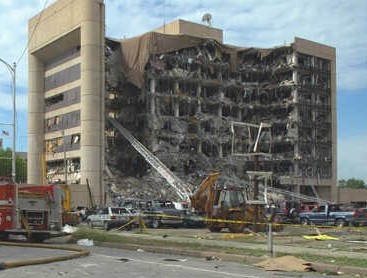 McVeigh visited the happy family frequently at the Michigan farm, while working as a security guard in nearby upstate New York and later when he took up drifting as a full-time vocation. His visits were all kinds of happy -- happy male bonding with best buddy Terry, and the occasional happy boink-fest with Marife which he wisely kept under wraps (a well-armed cuckold is still well-armed).
McVeigh visited the happy family frequently at the Michigan farm, while working as a security guard in nearby upstate New York and later when he took up drifting as a full-time vocation. His visits were all kinds of happy -- happy male bonding with best buddy Terry, and the occasional happy boink-fest with Marife which he wisely kept under wraps (a well-armed cuckold is still well-armed). 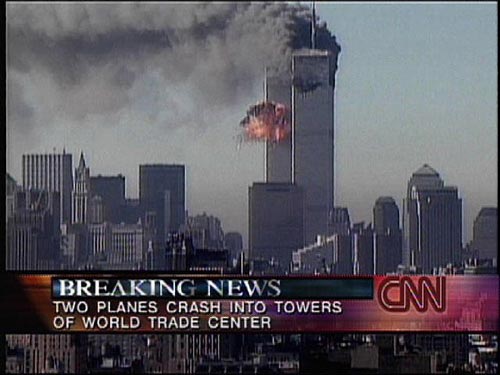 Angeles was a somewhat dubious figure; there are several accounts of this meeting which conflict in various details. Nevertheless, Angeles had been known to provide useful and correct information before his mysterious assassination a few years later.
Angeles was a somewhat dubious figure; there are several accounts of this meeting which conflict in various details. Nevertheless, Angeles had been known to provide useful and correct information before his mysterious assassination a few years later. 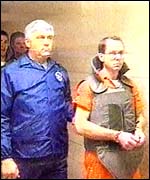 McVeigh made himself scarce during this time, keeping in contact with Nichols over the phone. In mid-April, however, he arrived in Kansas and began meeting with Nichols to discuss the bomb plans. On Easter Sunday, April 16, Nichols and McVeigh drove to Oklahoma City and scouted the Murrah Federal Building. On April 18, Nichols allegedly helped McVeigh mix and assemble the bombs's ingredients at a Kansas state park. (This too was denied by Nichols.)
McVeigh made himself scarce during this time, keeping in contact with Nichols over the phone. In mid-April, however, he arrived in Kansas and began meeting with Nichols to discuss the bomb plans. On Easter Sunday, April 16, Nichols and McVeigh drove to Oklahoma City and scouted the Murrah Federal Building. On April 18, Nichols allegedly helped McVeigh mix and assemble the bombs's ingredients at a Kansas state park. (This too was denied by Nichols.) 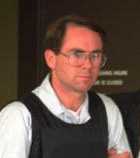 This being America, there was a school of thought that life in prison really wasn't enough. The state of Oklahoma charged Nichols with murder, hoping to finish the job. The trial was a fiasco from the beginning.
This being America, there was a school of thought that life in prison really wasn't enough. The state of Oklahoma charged Nichols with murder, hoping to finish the job. The trial was a fiasco from the beginning.